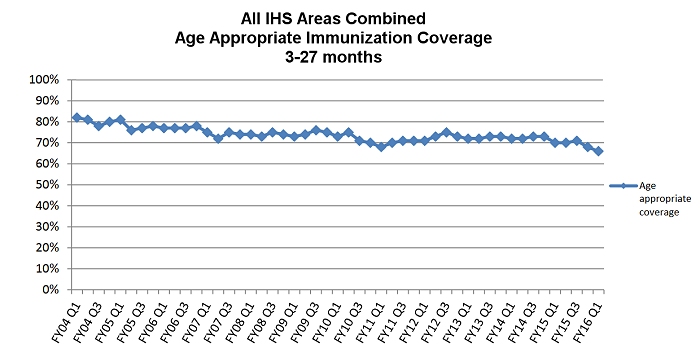During National Infant Immunization Week, April 16-23, IHS encourages every parent to double check their child’s immunization record to see if their child is up to date on recommended vaccines, and to discuss with neighbors, friends, and family the importance of vaccinating their children. Call your local clinic today to make an appointment to get your child vaccinated or to discuss childhood immunizations.
Immunization against childhood disease is one of the greatest public health achievements in the United States and worldwide. This week is an annual observance to highlight the importance of protecting infants from vaccine preventable diseases (VPD) and to celebrate the achievement of immunization programs and their partners. IHS is proud of the strong work the IHS/Tribal/Urban immunization programs have done and continue to do to increase vaccine uptake in infants.
Currently VPD rates in the United States are at or near record lows. Similar to the U.S., rates of VPDs in American Indian/Alaska Native (AI/AN) communities have decreased dramatically due to vaccines. Before vaccines, many children died from diseases, such as whooping cough, measles and polio. Since infants are protected by vaccines, we don’t see these diseases nearly as often.
The benefits of childhood immunizations are particularly notable for AI/AN children, who have suffered disproportionately from infectious diseases compared with the U.S. general population. Certain VPDs occur at higher rates for AI/AN infants than in their non-Native counterparts, due in part to issues such as household crowding, lack of indoor plumbing, poverty and poor indoor air quality. Though infections such as whooping cough, measles and polio are not as common as they were before vaccines, it is still critical that parents vaccinate their children because the germs that cause those diseases still exist.
As shown in the graph, there has been a steady decline in infant immunization rates across IHS. A decline in immunization coverage results in more children in your community being at risk for VPDs. It is especially important that parents vaccinate their children according to the recommended vaccine schedule to ensure they are fully protected from VPDs.

View the easy to read vaccine schedules for parents .
Dr. Steve Holve, is the Chief Clinical Consultant in Pediatrics at the Tuba City Regional Health Care Corporation for the Indian Health Service.




